Returns To Scale
The concept of variable proportions is a short-run phenomenon as in these period fixed factors cannot be changed and all factors cannot be changed. On the other hand in the long-term all factors can be changed as made variable. When we study the changes in output when all factors or inputs are changed, we study returns to scale. An increase in the scale means that all inputs or factors are increased in the same proportion. In variable proportions, the cooperating factors may be increased or decreased and one faster (Ex. Land in agriculture (or) machinery in industry) remains constant so that the changes in proportion among the factors result in certain changes in output. In returns to scale, all the necessary factors or production are increased or decreased to the same extent so that whatever the scale of production, the proportion among the factors remains the same.
Assumptions
- Technique of production is unchanged
- All units of factors are homogeneous
- Returns are measured in physical terms
When a firm expands, its scale increases all its inputs proportionally, then technically there are three possibilities.
- Law of increasing returns to scale: If a proportionate/percentage increase in the output is larger than the proportionate/percentage increase in inputs, there are increasing returns.
For example: If a 5% increase in inputs, results in 10% increase in the output, a firm is said to attain increased returns.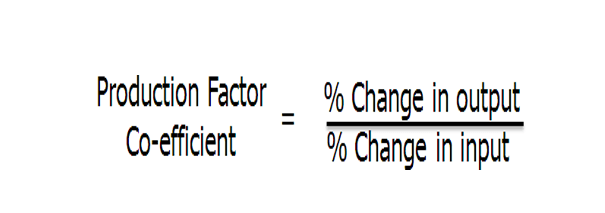
Law of increasing returns to scale
If PFC > 1, it means increasing returns to scale
If PFC = 1, it means constant returns to scale
If PFC < 1, it means decreasing returns to scale
- Law of increasing returns to scale: If a proportionate/percentage increase in the output is larger than the proportionate/percentage increase in inputs, there are increasing returns.
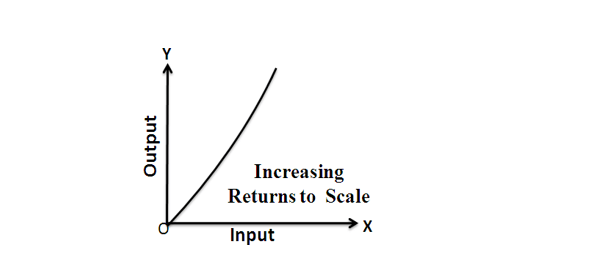
- Law of constant returns to scale: If the proportionate increase in all the inputs is equal to the proportionate increase in output, then situation of constant returns to scale occurs.
For example: If the inputs are increased at 10% and if the resultant output also increases a 10% then the organization is said to achieve constant returns to scale.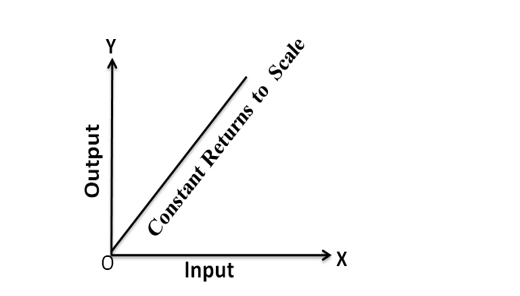
Law of constant returns to scale - Law of decreasing returns to scale: If the proportionate increase in output is less than the proportionate increase in input, then a situation of decreasing returns to scale occurs.
For example: If the inputs are increased by 10% and if the resultant output increases only by 5% then the organization is said to achieve decreasing returns to scale.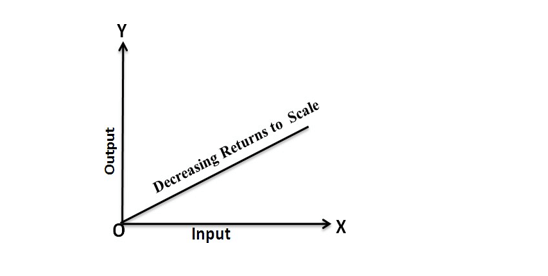
Law of decreasing returns to scale
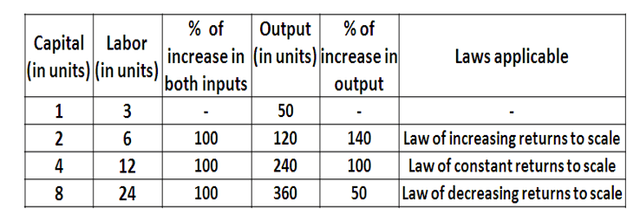
From the above table it is clear that with 1 unit of capital and 3 units of labor, the firm produces 50 units of output. When the inputs are doubled 2 units of capital and 6 units of labor, the output has gone up to 120 units. Thus when inputs are increased by 100%, the output has increased by 140%. That is, output has increased by more than double. This is governed by law of increasing returns to scale.
When the inputs are further doubled that is to 4 units of capital and 12 units of labor, the output has gone to 240 units. Thus, when inputs are increased by 100%., the output has increased by 100%. That is, output has doubled. This is governed by law of constant returns to scale.
When the inputs further doubled, that is, to 8 units of capital and 24 units of labor, the output has gone up to 360 units. Thus, when inputs are increased by 100%, the output has increased by only 50%. This is governed by law of decreasing returns to scale.
